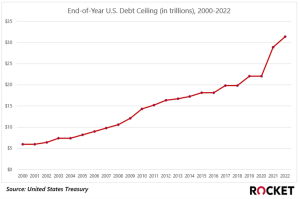Fannie Mae, the leading source of mortgage financing in the United States, has exciting news…
U.S. Debt Ceiling
What is the debt ceiling or debt limit exactly? The debt limit is the total amount of money that the United States government is authorized to borrow to meet its existing legal obligations, including Social Security and Medicare benefits, military salaries, interest on the national debt, tax refunds, and other payments.
The debt limit does not authorize new spending commitments. It simply allows the government to finance existing legal obligations that Congresses and presidents of both parties have made in the past.
Congress has always acted when called upon to raise the debt limit. Since 1960, Congress has acted 78 separate times to permanently raise, temporarily extend, or revise the definition of the debt limit – 49 times under Republican presidents and 29 times under Democratic presidents. Congressional leaders in both parties have recognized that this is necessary. Since it was last raised in 2021, the government can only borrower up to $31.4 trillion, yes trillion. This limit was hit in January. The government has been able to bridge the gap until June 1st. After June 1st the government will no longer be able to meet its obligations.
If there is no deal prior to June 1st, the US defaults on its debt. This would put the nation’s credit rating at risk, which would devalue bonds. When bond prices drop interest rates rise. Interest rates have risen dramatically over the past two years so this would be less than ideal. Furthermore, the U.S. government issues bonds to investors as a way to pay its debts. This would create a domino effect that would likely result in a major recession. Hopefully, like the previous 78 times the debt limit was raised, a deal can be met soon.




